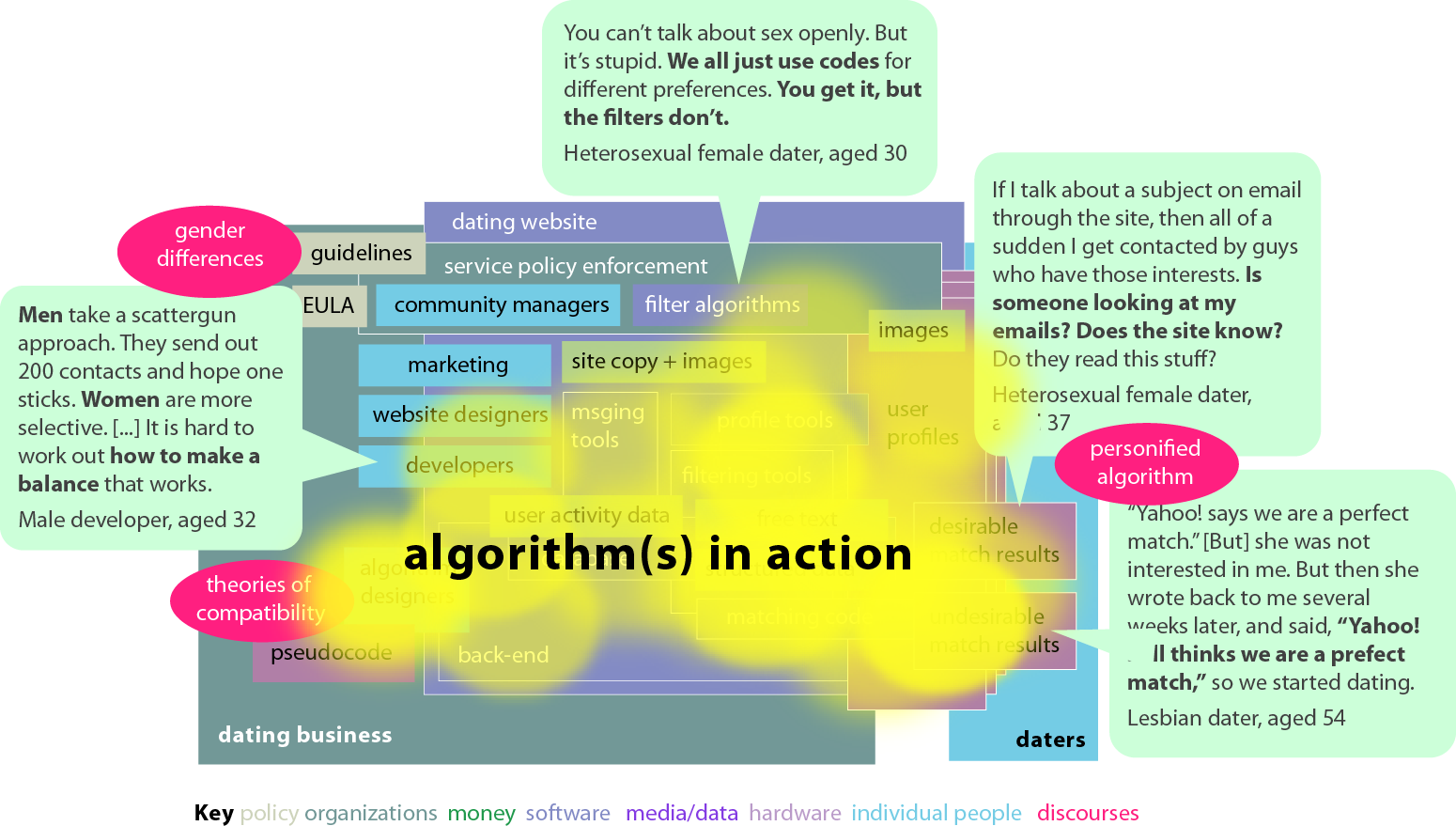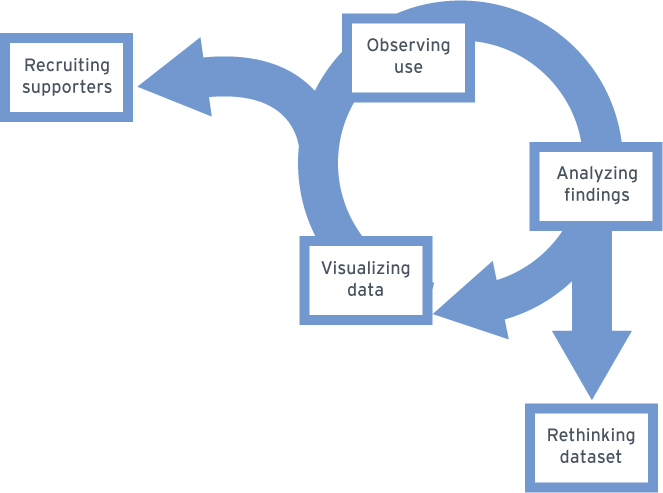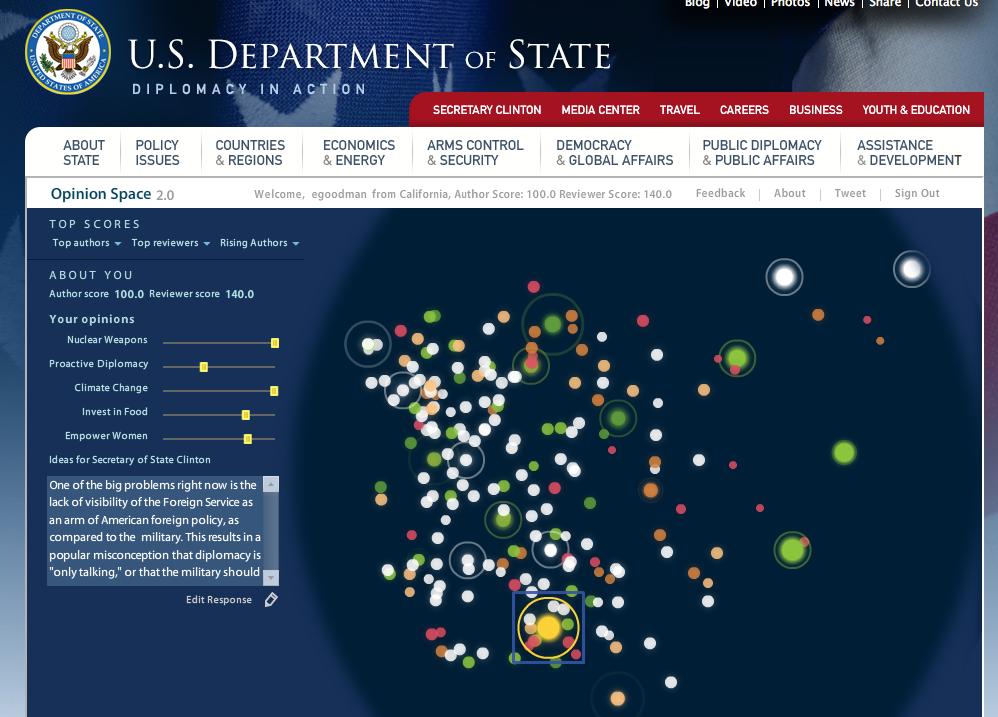Elizabeth Goodman. May-June 2014. Design and ethics in the era of big data. interactions 21, 3 (May 2014), 22-24.
May 15 | The Algorithm Multiple, The Algorithm Material: Reconstructing Creative Practice | UC Davis
Traditionally, computer scientists define an algorithm as a list of instructions for accomplishing a single goal. This definition treats an algorithm as (1) a coherent, usually textual, single object that (2) can be separated from its technological execution. Instead, we argue for the usefulness of studying algorithms in and as action. Algorithms-in-action, particularly computational algorithms, depend on actors outside them: the sources of the data they require as inputs, the machines that execute them, the storehouses that maintain their results and make them available for other processes, and so on. Algorithms are not stable texts but rather more-or-less stable agglomerations of people, machines, policies, data, and so on whose dimensions and components change over time. Our talk will examine the multiplicity and contingency of algorithms through two case studies from very different algorithmic sites — architectural software, and online dating services. Using those sites as springboards, it will argue that taking algorithms as multiple rather than singular and as material agglomerations rather than discursive texts opens up new entry points for creative and critical practice in design, the arts, and engineering.
Data as process
Talk, Data & Cities Conference, Stamen Design, San Francisco – 2011
Opinion Space
Opinion Space will harness the power of connection technologies to provide a unique forum for international dialogue. This is…an opportunity to extend our engagement beyond the halls of government directly to the people of the world.
U.S. Secretary of State Hillary Clinton 2010
Opinion Space is an online platform designed to promote more nuanced dialogue and surface insightful ideas. It asks participants to vote on a series of questions, then asks them to contribute a comment.
Instead of representing comments in a long list, it places them as dots within a three-dimensional space. The location of the dots is derived from participants’ votes using collaborative filtering and multidimensional visualization techniques. The resulting “map” highlights overall patterns and insightful individuals that might otherwise get lost in the crowd.
A version of Opinion Space is now in use at the US State Department as part of their public diplomacy initiative.
I was Opinion Space’s original interaction designer from 2009 to 2010, working on both the initial Berkeley prototype and then the version deployed for the US State Department.
Press about Opinion Space
- US Department of State Blog (Dipnote): http://blogs.state.gov/index.php/site/entry/opinionspace_global_digital_conversation
- US. Department of State Announcement: http://www.state.gov/r/pa/prs/ps/2010/03/138326.htm
- Harvard Journalism Lab: http://www.niemanlab.org/2010/03/global-opinions-visualized-the-state-departments-opinion-space/#more-13891
- Tech President Blog: http://techpresident.com/blog-entry/state-departments-brand-new-opinion-driven-global-data-visualization-thingy
- CBS News: http://www.cbsnews.com/video/watch/?id=6307886n&tag=api
- UK Guardian: http://www.guardian.co.uk/commentisfree/cifamerica/2010/mar/18/opinion-space-state-department
- Government Technology Times: http://www.govtech.com/gt/articles/750825
- Bay Citizen: http://www.baycitizen.org/columns/brainstorm/civility-algorithm/
- ICT4Peace: http://ict4peace.wordpress.com/2010/03/16/opinion-space-a-compelling-new-initiative-from-us-state-department/
- Wired News: http://www.wired.com/epicenter/2009/04/new-tool-shows/
- SF Chronicle: http://www.sfgate.com/cgi-bin/blogs/techchron/detail?blogid=19&entry_id=38849
- Fast Company: http://www.fastcompany.com/1586879/us-state-department-cozies-up-to-social-media-and-infographics
- Network World: http://www.networkworld.com/community/node/59390
Three Environmental Discourses in HCI.
Goodman, E. 2009. Three Environmental Discourses in HCI. In Proc. CHI EA ’09: 2535-2544.
Seeing fit: tracking and visualizing fitness data
Seeing fit: visualizing physical activity in context
This paper describes the results of a three month study of physical fitness in the United States. Using a literature review, blog readings, interviews, and diary studies, the authors identify key challenges and opportunities for technology to support fitness behaviors. Results focus on implications for the design and implementation of personal health visualization software.
Goodman, E., Foucault, B. 2006. Seeing fit: visualizing physical activity in context. In CHI’06 EA: 797-802.
The Familiar Stranger: Anxiety, Comfort, and Play in Public Places
Paulos, E. and Goodman, E. 2004. The Familiar Stranger: Anxiety, Comfort, and Play in Public Places. In Proc. CHI ’04: 223-230.
Continue reading “The Familiar Stranger: Anxiety, Comfort, and Play in Public Places”


